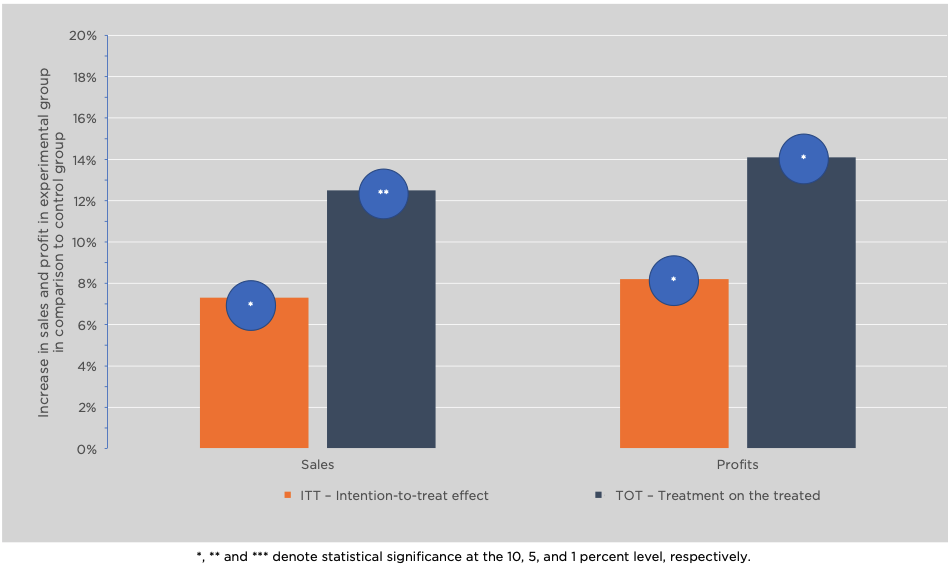Experimental Evidence on Heuristic-Based Business Training

Context
For many microentrepreneurs and small businesses in developing countries, a lack of business knowledge is a major obstacle to economic success. In response, business trainings have become an essential strategy to foster growth and economic resilience. However, the evidence on these trainings is mixed. It is therefore important to explore when and how business trainings are successful in supporting small businesses.
The Project
To expand knowledge on business trainings in Latin America, this experiment tested their effectiveness in Ecuador in 2015/2016. Building on more recent literature, more traditional, information-heavy business trainings were compared to behaviorally-informed business trainings, which make use of heuristics to simplify information and cognitive processes. The project further explored potential channels that affected the success of the intervention as well as gender dynamics.
The intervention used a randomized-control trial, in which one group received a traditional business training, one group a behaviorally-informed business training, and one served as a control group.
Behavioral Analysis
Behavioral Barriers
Cognitive overload: The cognitive load is the amount of mental effort and memory used at a given moment in time. Overload is when the volume of information provided exceeds an individual's capacity to process it. We have limited amounts of attention and memory, which means we are not able to process all the information available. In this context, traditional trainings might require more “bandwidth” and/or attention than trainees have available.
Hassle factors: We frequently do not act on our intentions because of small factors or inconveniences that hinder us or make the action uncomfortable. In the case of trainings, this could simply be the way in which the information is presented, the length of presentation, or that additional actions must be taken to execute a decision. Business owners might not use lessons they learn in a traditional training because it does not provide clear guidance and actionable steps on concrete objectives such as how to increase savings.
Behavioral Tools
Simplification: Reducing the effort required to perform an action by making the message clearer, cutting the number of steps or breaking down into simple, easier steps a complex goal. In this case, the rules of thumb for business management are e perfect example of simplification.
Commitment mechanisms: This is a choice made in the present that restricts future options to those reflecting long-term objectives. They therefore serve as mechanisms for mitigating future impulsive behavior. Based on our tendency toward inertia, this mechanism can help address time inconsistency and cognitive overload. The study asked participants to commit to a “30-Day Challenge” in which their adoption of the newly acquired heuristics would be tracked.
Micro-incentives: Rewards or punishments offered to decision-makers with the aim of influencing their behavior or decision. They may be tangible, such as food or money, or intangible, such as public recognition. In contrast to the incentives that form an integral part of policy design, these are small, low-cost, and easy-to-apply signals that complement the original design. Offering micro-incentives can thus help to mitigate loss aversion and present bias. In this case, entrepreneurs received stickers in their financial journal and were admitted to a lottery to win a cash register upon fulfilling certain implementation steps of the heuristics.
Intervention Design
For the experiment, the IDB Lab partnered with Banco Pichincha to test and design two types of training in the Ecuadorian provinces of Pichincha and Guayas. Overall, 2,408 micro and small entrepreneurs participated in the randomized-control trial. All 2,408 businesses initially also served as “non-bank correspondents,” which means that they were contracted by a financial institution to channel and process financial transactions of the bank’s clients.
The traditional training covered three modules related to financial management and accounting: organization and financial planning, credit, and saving and financial goals. The heuristics training was based on best practices identified in interviews with successful small business managers packaged into four behavioral rules of thumb: set up (general structure for cash flow and expenses); sell and tally (daily operations); pay out (paying down debt); and save up (system for regular savings). The heuristics training also employed a different pedagogical approach.
The underlying theory of change of this intervention was based on the assumption that heuristics are highly efficient in reducing cognitive load. Furthermore, their simplicity allows business owners to recall them easily and to complete tasks in a few simple steps. To investigate this mechanism, the study also assessed the attention span of entrepreneurs. The main outcome measures were entrepeneurs’ profits and sales.
Of the 2,408 entrepreneurs, 803 received a traditional training, 801 the behaviorally-informed heuristics training, and 804 served as a control group. The sample was stratified according to province and a measure related to the number of financial transactions. The baseline survey was conducted between August and October 2015, and the trainings started implementation in November 2015. An end line survey was then conducted between November and December 2016 after the intervention was complete.
Challenges
- The small entrepreneurs who participated were not randomly chosen. Rather, only entrepreneurs who function as non-bank correspondents participated, which might limit the generalizability of the findings across all kinds of entrepreneurs.
- Like other experiments, this study was confronted with exits of business and drop-outs from the non-bank correspondent business. However, exit rates were not statistically different from zero across the three groups.
The costs for implementation and the design of the heuristics training are significantly higher than for the traditional training, necessitating higher investment in the first place.
Results
- Results indicate that the heuristics intervention had a significant and economically meaningful impact on sales and profits in comparison to the control group (0.06 and 0.08 standard deviations, respectively), equivalent to increases of 7.3 and 8.2 percent, respectively, for the intention-to-treat effect (ITT). Effects on the treated (OTT) were higher, translating to a 12.5 percent increase in sales and 14.1 percent in profits (Figure 1). The significant and positive impact of the heuristics-based training seems to be driven by the training’s effect on sales and profits for regular and good business days. In contrast, the effects of traditional trainings are not statistically different from the control group.
- The study finds that the major progress induced by the training related to the entrepreneur’s improved inventory management. In addition, the fact that individual attention span seems to be a moderating factor indicates that heuristics-based trainings might be especially useful for people with a high cognitive load (high number of simultaneous duties) or with low ability to focus.
- Cost-benefit analysis reveal that the heuristics training’s rate of return is high, amounting to 133 percent (37 percent if costs are included), or estimated as an average extra profit per month per participant of US$ 104 (Table 1).
- Looking at sub-population effects, the training has a larger impact for women and for people with a low attention span. Also, women seem to apply the rules of thumb more often than men.
Figure 1. Treatment Effects of the Intervention on Sales and Profits.

Table 1. Cost-Benefit Analysis of the Intervention.

Policy Implications
- In line with more recent work on behaviorally-informed business trainings, the experiment demonstrates the high potential benefit of heuristics-based trainings for small business. In this case, it led to sizable economic benefits for entrepreneurs.
- The intervention demonstrated high cost-effectiveness, and the targeted underlying cognitive mechanism (cognitive load and attention) seems to be highly generalizable across different regions.
- If scaled successfully, this intervention might make a significant contribution to the stability of small business in the region.
